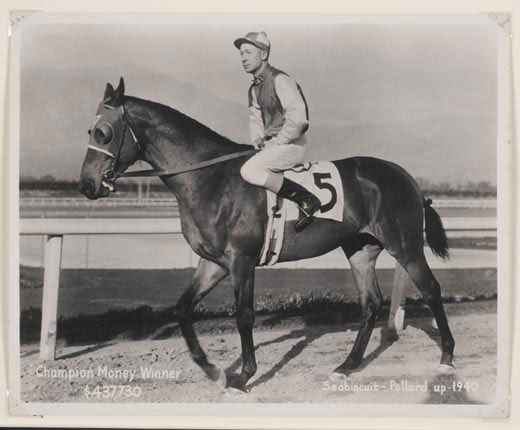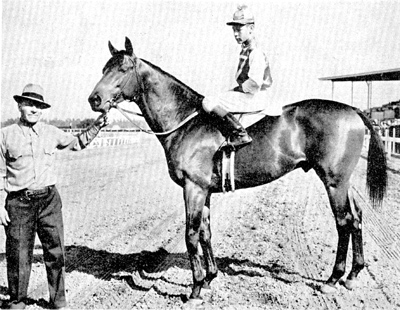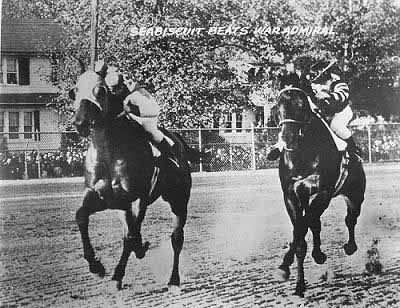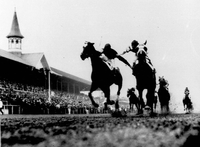Seabiscuit: An American Legend
<>
Seabiscuit became one of thoroughbred racings greatest legends at a time when the sport needed it the most. At age 2 he had raced a record 35 times with only 5 wins to his name. He went on to race 23 more times at the age of 3, capturing 9 of these outings, before he was claimed by Charles and Marcella Howard after winning a claiming race at Saratoga. Then Seabiscuit was in the hands of his new trainer, Tom Smith, an old western cowboy who knew how to communicate with horses like no other.
Smith remembered having seen the colt race a month earlier at Suffolk Downs. He was not surprised that Seabiscuit was tired and sore after all he had done in just 2 years at the track. The horse was 200 pounds underweight with a weary temperament. He raised hell at the starting gate, intimidated the grooms, nervously paced his stall, and refused to eat. Seabiscuit was in serious need of some rest and relaxation, and a chance to form a bond with people. Tom Smith babied his new colt in hopes of Seabiscuit one day living up to his potential as the grandson of the mighty Man O?War. He put leg braces and bandages on Biscuit뭩 legs, and equipped him with blinkers for training and racing to keep his mind on business. He also gave his colt a double sized stall complete with roommates. Seabiscuit's new companions were a stray dog named Pocatell, a spider monkey known as Jo Jo, and his lifelong traveling mate, a calm horse name Pumpkin. Once Seabiscuit뭩 nerves had been calmed and his ailments had been treated, Smith decided it was time to return him to the races.
He chose Johnny Pollard to be Seabiscuit뭩 new jockey. Pollard was an ex-boxer that was blind in one eye, and at five feet, seven inches, towered over most other jocks. His career had been on the decline when he walked into Smith뭩 barn that summer of ?6. He and Seabiscuit took to each other immediately, with Pollard affectionately nicknaming him 밣ops? Between the care he received from both Smith and Pollard, Seabiscuit flourished. The once neurotic, skittish animal became easygoing and sociable. For the remainder of the year the trainer and the jockey worked with Seabiscuit by running him in small allowance races and putting him through intensive schooling. Towards the end of ?6, Seabiscuit won the Scarsdale Handicap in track record time, and then went on to win the west over by claiming victories in two major races in California, just missing two world records in the process.
1937 began Seabiscuit뭩 4 year old season at Santa Anita, where he won his first race of the year. He then went on to run in the prestigious Santa Anita Handicap against 17 other competitors. With one furlong to go in the race there was no one ahead of him. It looked like he was going to win, but neither horse nor jockey noticed the closer Rosemont, whom Seabiscuit had defeated just one month earlier, gaining on them with every stride. And then, it was too late. 멊iscuit lunged at the last second to induce a photo finish, but he had lost by a nose. Even so, the horse had started to become a celebrity. Howard began promoting his colt, and raced him on 18 tracks in 7 states and Mexico that year. He raced on both coasts, winning ten major races and tying five track records while becoming the leading money winner for 1937, and only finishing off the board once. However, he was not named Horse of the Year. That honor went to a 3 year old, the near-black, east coast based Triple Crown winner War Admiral.
Seabiscuit뭩 5 year old season started off with a bang, as just weeks before he was to run in the Santa Anita Derby for the second time, he was jockey less. Pollard had been injured in a spill and was told it would be at least a year before he could ride again. He recommended his good friend George Woolf to take over the riding duties of his beloved Seabiscuit. Woolf was the son of a bronc buster, fearless, diabetic, and one of the greatest riders thoroughbred racing has ever seen. Nicknamed 밫he Iceman? he was known to time his horses?closing stretch drives so precisely that he won on a regular basis. He made it a point to know his mounts well, as long as every one else뭩 with the same attentiveness. The 1938 Santa Anita 멌ap imposted 130 pounds upon the mighty Seabiscuit, with him giving as much as 30 pounds to his competitors. At the break, he was knocked nearly to the ground. Woolf sent him in a drive to make up the distance, and thinking he had his main rival Stagehand beat, let Seabiscuit settle. Sadly, this was not the case, as Stagehand began to close upon the bay colt. He drew even, and Woolf asked 멊iscuit for everything he had. Miraculously, his colt came back, resulting in a head-bobbing duel all the way to the wire. But this was not to be his Santa Anita 멌ap either; Stagehand had gotten in front at the finish. That same afternoon in Florida, War Admiral had gone on to win his 10th consecutive race. The public clamored for a match race between the two colts, and Belmont Park offered $100,000 for battle between the two thoroughbreds in May. Both owners accepted but a flare-up in 멊iscuit뭩 bad leg forced a cancellation, and was instead entered in the Mass 멌ap for June along with the Admiral. Minutes before the race, with the Suffolk Downs grandstand overflowing, Smith discovered his colt had again injured his leg and scratched him from the race. Once Seabiscuit healed he went on to win the Hollywood Gold Cup in California and smash the race뭩 record along the way. Afterwards, Howard brought him back east, eager to see his horse meet up with War Admiral.
By summer of ?8, Pollard began riding again. One morning, he decided to ride a horse for another trainer in a morning workout. The colt rammed Pollard through the track rail and into the side of a barn, almost severing the jockey뭩 leg. After seeing a team of doctors, the jock was told he might never walk again.
In the fall of 1938, it seemed the big match race would finally happen. Alfred Vanderbilt, the president of Pimlico Racecourse, wanted nothing more than the race to be run there. He couldn뭪 offer a large purse, but appeased to Riddle뭩 and Howard뭩 sportsmanship attitude by explaining to them how good it would be for racing. The mile and three-sixteenths Pimlico Special would be held November 1, 1938, with a winner take all purse of $15,000. Each horse would carry 120 pounds, and would break from a walk-up start instead of a gate. They were both favorites in their own way. Seabiscuit had captured the hearts of the fans, while War Admiral captured their betting money. Many predicted that the Admiral would run away with the race right off the starting line, as 멊iscuit was not known for his fast breaks. But that was about to change.
Smith trained his colt to break off in a hurry, first by fashioning a starting bell to accustom him with the noise, and then by running him with top sprinters. Seabiscuit learned to give everything he had into speeding away at the start of the race. By midday on November first, a record 40,000 spectators squeezed themselves into Pimlico뭩 tiny racetrack, pouring over into the infield. At 4 pm, War Admiral and Seabiscuit stepped out onto the track. They stepped up to the line together, and at the sound of the bell, 멊iscuit took off like a bolt of lightning. He opened up to a two length lead until the half mile pole, when the Admiral was in full stride at his shoulder. But Seabiscuit wouldn뭪 let him pass, he refused to give up his lead. He even cocked his ear towards his rival, but then, War Admiral pushed his head in front. The colt, however, was struggling, and Woolf knew the race was theirs. He pushed his little bay for just a little more, and 멊iscuit sailed to a four length lead over the younger near black horse, finishing in near world record time. This year, Seabiscuit claimed Horse of the Year honors.
In January, at the start of his 6 year old season, Howard pointed him yet again towards the elusive Santa Anita Derby. It would be Seabiscuits third try for the one race his owners so badly wanted him to win. But it would be another year before 멊iscuit could even attempt it again. As he made his closing move in a prep race, the colts longtime ailing left front tendon finally ruptured. He managed to hang on for second but all though his career would be over. He was sent to Howard뭩 ranch and for nine months wandered a paddock, became fat, and tried to race deer along the fences. Meanwhile, Pollard had endured several leg operations and was beginning to hobble on crutches. He stayed at Ridgewood Ranch with his dear racehorse Pops. Once the colt was no longer lame, Pollard began riding him to build his own strength and to ready 멊iscuit for a return to racing. By the end of ?9, he was once again a sound horse, and Howard decided to try for a comeback in 1940.
At 7 years of age, Seabiscuit was more than twice the age of some of his rivals. But his team of Howard, Smith, and Pollard believed him to be capable, even though no horse had ever returned to top form after such an injury and long layoff. Pollard was determined to ride him, and win on him, again, even though he now required a steel brace on his leg to ride. They set out to chase the Santa Anita Handicap. 밢ld Pops and I have got four good legs between us,?said Pollard. 밠aybe that뭩 enough.? Seabiscuit and Pollard received a standing ovation as they stepped onto the track for their dream chased handicap. A crowd of 70,000 had gathered to witness the 1940 Santa Anita 멌ap, and this time they would not be disappointed. 멊iscuit broke well and and settled into striking position. He was shouldered into a pocket and Pollard momentarily panicked, thinking that once again the race would be lost. But then space opened up and Seabiscuit shot through. The closer and defending champion Kayak II came up to challenge then, and 멊iscuit looked him in the eye, teased him a bit, and then swept ahead to win the handicap while running the second fastest mile and a quarter in American racing history.
Seabiscuit was finished. In six years of racing, he had competed 89 times, winning 33 of these matches, finishing on the board 61 times, (more so in his later years), set 16 track records, and equaled another. Having won $437,730 in purse money, he was worth his weight in gold to the Howards, who had purchased him for a mere $7,500. it was time to retire. Seabisciut was going home to Ridgewood Ranch. On May 17th, 1947, the great and mighty champion suffered a heart attack at only 14 years of age. He was buried on a secret site on the ranch, with only an oak sapling to mark its location.
Above biography by Raelyn Mezger



<>
Seabiscuit became one of thoroughbred racings greatest legends at a time when the sport needed it the most. At age 2 he had raced a record 35 times with only 5 wins to his name. He went on to race 23 more times at the age of 3, capturing 9 of these outings, before he was claimed by Charles and Marcella Howard after winning a claiming race at Saratoga. Then Seabiscuit was in the hands of his new trainer, Tom Smith, an old western cowboy who knew how to communicate with horses like no other.
Smith remembered having seen the colt race a month earlier at Suffolk Downs. He was not surprised that Seabiscuit was tired and sore after all he had done in just 2 years at the track. The horse was 200 pounds underweight with a weary temperament. He raised hell at the starting gate, intimidated the grooms, nervously paced his stall, and refused to eat. Seabiscuit was in serious need of some rest and relaxation, and a chance to form a bond with people. Tom Smith babied his new colt in hopes of Seabiscuit one day living up to his potential as the grandson of the mighty Man O?War. He put leg braces and bandages on Biscuit뭩 legs, and equipped him with blinkers for training and racing to keep his mind on business. He also gave his colt a double sized stall complete with roommates. Seabiscuit's new companions were a stray dog named Pocatell, a spider monkey known as Jo Jo, and his lifelong traveling mate, a calm horse name Pumpkin. Once Seabiscuit뭩 nerves had been calmed and his ailments had been treated, Smith decided it was time to return him to the races.
He chose Johnny Pollard to be Seabiscuit뭩 new jockey. Pollard was an ex-boxer that was blind in one eye, and at five feet, seven inches, towered over most other jocks. His career had been on the decline when he walked into Smith뭩 barn that summer of ?6. He and Seabiscuit took to each other immediately, with Pollard affectionately nicknaming him 밣ops? Between the care he received from both Smith and Pollard, Seabiscuit flourished. The once neurotic, skittish animal became easygoing and sociable. For the remainder of the year the trainer and the jockey worked with Seabiscuit by running him in small allowance races and putting him through intensive schooling. Towards the end of ?6, Seabiscuit won the Scarsdale Handicap in track record time, and then went on to win the west over by claiming victories in two major races in California, just missing two world records in the process.
1937 began Seabiscuit뭩 4 year old season at Santa Anita, where he won his first race of the year. He then went on to run in the prestigious Santa Anita Handicap against 17 other competitors. With one furlong to go in the race there was no one ahead of him. It looked like he was going to win, but neither horse nor jockey noticed the closer Rosemont, whom Seabiscuit had defeated just one month earlier, gaining on them with every stride. And then, it was too late. 멊iscuit lunged at the last second to induce a photo finish, but he had lost by a nose. Even so, the horse had started to become a celebrity. Howard began promoting his colt, and raced him on 18 tracks in 7 states and Mexico that year. He raced on both coasts, winning ten major races and tying five track records while becoming the leading money winner for 1937, and only finishing off the board once. However, he was not named Horse of the Year. That honor went to a 3 year old, the near-black, east coast based Triple Crown winner War Admiral.
Seabiscuit뭩 5 year old season started off with a bang, as just weeks before he was to run in the Santa Anita Derby for the second time, he was jockey less. Pollard had been injured in a spill and was told it would be at least a year before he could ride again. He recommended his good friend George Woolf to take over the riding duties of his beloved Seabiscuit. Woolf was the son of a bronc buster, fearless, diabetic, and one of the greatest riders thoroughbred racing has ever seen. Nicknamed 밫he Iceman? he was known to time his horses?closing stretch drives so precisely that he won on a regular basis. He made it a point to know his mounts well, as long as every one else뭩 with the same attentiveness. The 1938 Santa Anita 멌ap imposted 130 pounds upon the mighty Seabiscuit, with him giving as much as 30 pounds to his competitors. At the break, he was knocked nearly to the ground. Woolf sent him in a drive to make up the distance, and thinking he had his main rival Stagehand beat, let Seabiscuit settle. Sadly, this was not the case, as Stagehand began to close upon the bay colt. He drew even, and Woolf asked 멊iscuit for everything he had. Miraculously, his colt came back, resulting in a head-bobbing duel all the way to the wire. But this was not to be his Santa Anita 멌ap either; Stagehand had gotten in front at the finish. That same afternoon in Florida, War Admiral had gone on to win his 10th consecutive race. The public clamored for a match race between the two colts, and Belmont Park offered $100,000 for battle between the two thoroughbreds in May. Both owners accepted but a flare-up in 멊iscuit뭩 bad leg forced a cancellation, and was instead entered in the Mass 멌ap for June along with the Admiral. Minutes before the race, with the Suffolk Downs grandstand overflowing, Smith discovered his colt had again injured his leg and scratched him from the race. Once Seabiscuit healed he went on to win the Hollywood Gold Cup in California and smash the race뭩 record along the way. Afterwards, Howard brought him back east, eager to see his horse meet up with War Admiral.
By summer of ?8, Pollard began riding again. One morning, he decided to ride a horse for another trainer in a morning workout. The colt rammed Pollard through the track rail and into the side of a barn, almost severing the jockey뭩 leg. After seeing a team of doctors, the jock was told he might never walk again.
In the fall of 1938, it seemed the big match race would finally happen. Alfred Vanderbilt, the president of Pimlico Racecourse, wanted nothing more than the race to be run there. He couldn뭪 offer a large purse, but appeased to Riddle뭩 and Howard뭩 sportsmanship attitude by explaining to them how good it would be for racing. The mile and three-sixteenths Pimlico Special would be held November 1, 1938, with a winner take all purse of $15,000. Each horse would carry 120 pounds, and would break from a walk-up start instead of a gate. They were both favorites in their own way. Seabiscuit had captured the hearts of the fans, while War Admiral captured their betting money. Many predicted that the Admiral would run away with the race right off the starting line, as 멊iscuit was not known for his fast breaks. But that was about to change.
Smith trained his colt to break off in a hurry, first by fashioning a starting bell to accustom him with the noise, and then by running him with top sprinters. Seabiscuit learned to give everything he had into speeding away at the start of the race. By midday on November first, a record 40,000 spectators squeezed themselves into Pimlico뭩 tiny racetrack, pouring over into the infield. At 4 pm, War Admiral and Seabiscuit stepped out onto the track. They stepped up to the line together, and at the sound of the bell, 멊iscuit took off like a bolt of lightning. He opened up to a two length lead until the half mile pole, when the Admiral was in full stride at his shoulder. But Seabiscuit wouldn뭪 let him pass, he refused to give up his lead. He even cocked his ear towards his rival, but then, War Admiral pushed his head in front. The colt, however, was struggling, and Woolf knew the race was theirs. He pushed his little bay for just a little more, and 멊iscuit sailed to a four length lead over the younger near black horse, finishing in near world record time. This year, Seabiscuit claimed Horse of the Year honors.
In January, at the start of his 6 year old season, Howard pointed him yet again towards the elusive Santa Anita Derby. It would be Seabiscuits third try for the one race his owners so badly wanted him to win. But it would be another year before 멊iscuit could even attempt it again. As he made his closing move in a prep race, the colts longtime ailing left front tendon finally ruptured. He managed to hang on for second but all though his career would be over. He was sent to Howard뭩 ranch and for nine months wandered a paddock, became fat, and tried to race deer along the fences. Meanwhile, Pollard had endured several leg operations and was beginning to hobble on crutches. He stayed at Ridgewood Ranch with his dear racehorse Pops. Once the colt was no longer lame, Pollard began riding him to build his own strength and to ready 멊iscuit for a return to racing. By the end of ?9, he was once again a sound horse, and Howard decided to try for a comeback in 1940.
At 7 years of age, Seabiscuit was more than twice the age of some of his rivals. But his team of Howard, Smith, and Pollard believed him to be capable, even though no horse had ever returned to top form after such an injury and long layoff. Pollard was determined to ride him, and win on him, again, even though he now required a steel brace on his leg to ride. They set out to chase the Santa Anita Handicap. 밢ld Pops and I have got four good legs between us,?said Pollard. 밠aybe that뭩 enough.? Seabiscuit and Pollard received a standing ovation as they stepped onto the track for their dream chased handicap. A crowd of 70,000 had gathered to witness the 1940 Santa Anita 멌ap, and this time they would not be disappointed. 멊iscuit broke well and and settled into striking position. He was shouldered into a pocket and Pollard momentarily panicked, thinking that once again the race would be lost. But then space opened up and Seabiscuit shot through. The closer and defending champion Kayak II came up to challenge then, and 멊iscuit looked him in the eye, teased him a bit, and then swept ahead to win the handicap while running the second fastest mile and a quarter in American racing history.
Seabiscuit was finished. In six years of racing, he had competed 89 times, winning 33 of these matches, finishing on the board 61 times, (more so in his later years), set 16 track records, and equaled another. Having won $437,730 in purse money, he was worth his weight in gold to the Howards, who had purchased him for a mere $7,500. it was time to retire. Seabisciut was going home to Ridgewood Ranch. On May 17th, 1947, the great and mighty champion suffered a heart attack at only 14 years of age. He was buried on a secret site on the ranch, with only an oak sapling to mark its location.
Above biography by Raelyn Mezger



Trackback URL : 이 글에는 트랙백을 보낼 수 없습니다
Trackback RSS : http://www.fallight.com/rss/trackback/438
Trackback ATOM : http://www.fallight.com/atom/trackback/438







